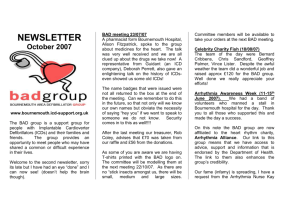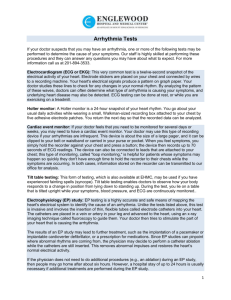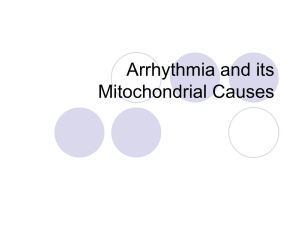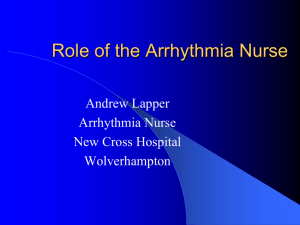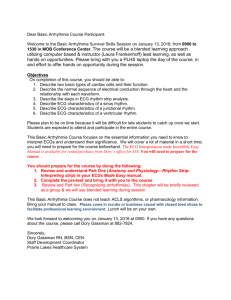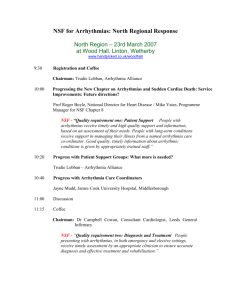ErbB receptor function by binding receptor but failing to induce signaling.
advertisement
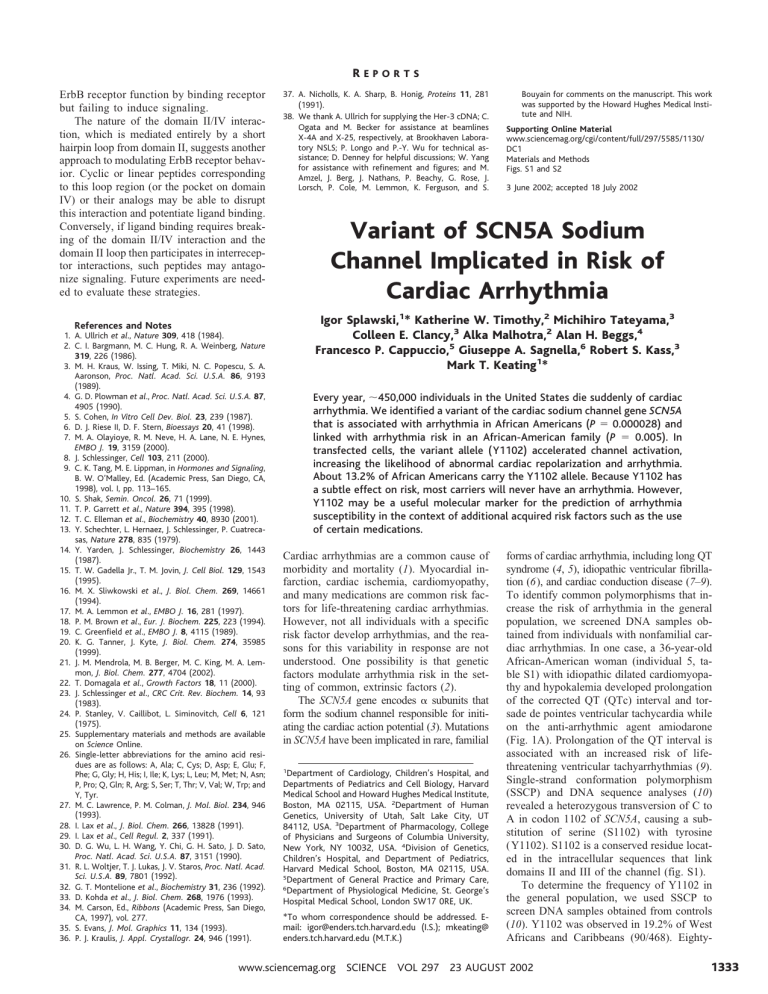
REPORTS ErbB receptor function by binding receptor but failing to induce signaling. The nature of the domain II/IV interaction, which is mediated entirely by a short hairpin loop from domain II, suggests another approach to modulating ErbB receptor behavior. Cyclic or linear peptides corresponding to this loop region (or the pocket on domain IV) or their analogs may be able to disrupt this interaction and potentiate ligand binding. Conversely, if ligand binding requires breaking of the domain II/IV interaction and the domain II loop then participates in interreceptor interactions, such peptides may antagonize signaling. Future experiments are needed to evaluate these strategies. References and Notes 1. A. Ullrich et al., Nature 309, 418 (1984). 2. C. I. Bargmann, M. C. Hung, R. A. Weinberg, Nature 319, 226 (1986). 3. M. H. Kraus, W. Issing, T. Miki, N. C. Popescu, S. A. Aaronson, Proc. Natl. Acad. Sci. U.S.A. 86, 9193 (1989). 4. G. D. Plowman et al., Proc. Natl. Acad. Sci. U.S.A. 87, 4905 (1990). 5. S. Cohen, In Vitro Cell Dev. Biol. 23, 239 (1987). 6. D. J. Riese II, D. F. Stern, Bioessays 20, 41 (1998). 7. M. A. Olayioye, R. M. Neve, H. A. Lane, N. E. Hynes, EMBO J. 19, 3159 (2000). 8. J. Schlessinger, Cell 103, 211 (2000). 9. C. K. Tang, M. E. Lippman, in Hormones and Signaling, B. W. O’Malley, Ed. (Academic Press, San Diego, CA, 1998), vol. I, pp. 113–165. 10. S. Shak, Semin. Oncol. 26, 71 (1999). 11. T. P. Garrett et al., Nature 394, 395 (1998). 12. T. C. Elleman et al., Biochemistry 40, 8930 (2001). 13. Y. Schechter, L. Hernaez, J. Schlessinger, P. Cuatrecasas, Nature 278, 835 (1979). 14. Y. Yarden, J. Schlessinger, Biochemistry 26, 1443 (1987). 15. T. W. Gadella Jr., T. M. Jovin, J. Cell Biol. 129, 1543 (1995). 16. M. X. Sliwkowski et al., J. Biol. Chem. 269, 14661 (1994). 17. M. A. Lemmon et al., EMBO J. 16, 281 (1997). 18. P. M. Brown et al., Eur. J. Biochem. 225, 223 (1994). 19. C. Greenfield et al., EMBO J. 8, 4115 (1989). 20. K. G. Tanner, J. Kyte, J. Biol. Chem. 274, 35985 (1999). 21. J. M. Mendrola, M. B. Berger, M. C. King, M. A. Lemmon, J. Biol. Chem. 277, 4704 (2002). 22. T. Domagala et al., Growth Factors 18, 11 (2000). 23. J. Schlessinger et al., CRC Crit. Rev. Biochem. 14, 93 (1983). 24. P. Stanley, V. Caillibot, L. Siminovitch, Cell 6, 121 (1975). 25. Supplementary materials and methods are available on Science Online. 26. Single-letter abbreviations for the amino acid residues are as follows: A, Ala; C, Cys; D, Asp; E, Glu; F, Phe; G, Gly; H, His; I, Ile; K, Lys; L, Leu; M, Met; N, Asn; P, Pro; Q, Gln; R, Arg; S, Ser; T, Thr; V, Val; W, Trp; and Y, Tyr. 27. M. C. Lawrence, P. M. Colman, J. Mol. Biol. 234, 946 (1993). 28. I. Lax et al., J. Biol. Chem. 266, 13828 (1991). 29. I. Lax et al., Cell Regul. 2, 337 (1991). 30. D. G. Wu, L. H. Wang, Y. Chi, G. H. Sato, J. D. Sato, Proc. Natl. Acad. Sci. U.S.A. 87, 3151 (1990). 31. R. L. Woltjer, T. J. Lukas, J. V. Staros, Proc. Natl. Acad. Sci. U.S.A. 89, 7801 (1992). 32. G. T. Montelione et al., Biochemistry 31, 236 (1992). 33. D. Kohda et al., J. Biol. Chem. 268, 1976 (1993). 34. M. Carson, Ed., Ribbons (Academic Press, San Diego, CA, 1997), vol. 277. 35. S. Evans, J. Mol. Graphics 11, 134 (1993). 36. P. J. Kraulis, J. Appl. Crystallogr. 24, 946 (1991). 37. A. Nicholls, K. A. Sharp, B. Honig, Proteins 11, 281 (1991). 38. We thank A. Ullrich for supplying the Her-3 cDNA; C. Ogata and M. Becker for assistance at beamlines X-4A and X-25, respectively, at Brookhaven Laboratory NSLS; P. Longo and P.-Y. Wu for technical assistance; D. Denney for helpful discussions; W. Yang for assistance with refinement and figures; and M. Amzel, J. Berg, J. Nathans, P. Beachy, G. Rose, J. Lorsch, P. Cole, M. Lemmon, K. Ferguson, and S. Bouyain for comments on the manuscript. This work was supported by the Howard Hughes Medical Institute and NIH. Supporting Online Material www.sciencemag.org/cgi/content/full/297/5585/1130/ DC1 Materials and Methods Figs. S1 and S2 3 June 2002; accepted 18 July 2002 Variant of SCN5A Sodium Channel Implicated in Risk of Cardiac Arrhythmia Igor Splawski,1* Katherine W. Timothy,2 Michihiro Tateyama,3 Colleen E. Clancy,3 Alka Malhotra,2 Alan H. Beggs,4 Francesco P. Cappuccio,5 Giuseppe A. Sagnella,6 Robert S. Kass,3 Mark T. Keating1* Every year, ⬃450,000 individuals in the United States die suddenly of cardiac arrhythmia. We identified a variant of the cardiac sodium channel gene SCN5A that is associated with arrhythmia in African Americans (P ⫽ 0.000028) and linked with arrhythmia risk in an African-American family (P ⫽ 0.005). In transfected cells, the variant allele (Y1102) accelerated channel activation, increasing the likelihood of abnormal cardiac repolarization and arrhythmia. About 13.2% of African Americans carry the Y1102 allele. Because Y1102 has a subtle effect on risk, most carriers will never have an arrhythmia. However, Y1102 may be a useful molecular marker for the prediction of arrhythmia susceptibility in the context of additional acquired risk factors such as the use of certain medications. Cardiac arrhythmias are a common cause of morbidity and mortality (1). Myocardial infarction, cardiac ischemia, cardiomyopathy, and many medications are common risk factors for life-threatening cardiac arrhythmias. However, not all individuals with a specific risk factor develop arrhythmias, and the reasons for this variability in response are not understood. One possibility is that genetic factors modulate arrhythmia risk in the setting of common, extrinsic factors (2). The SCN5A gene encodes ␣ subunits that form the sodium channel responsible for initiating the cardiac action potential (3). Mutations in SCN5A have been implicated in rare, familial 1 Department of Cardiology, Children’s Hospital, and Departments of Pediatrics and Cell Biology, Harvard Medical School and Howard Hughes Medical Institute, Boston, MA 02115, USA. 2Department of Human Genetics, University of Utah, Salt Lake City, UT 84112, USA. 3Department of Pharmacology, College of Physicians and Surgeons of Columbia University, New York, NY 10032, USA. 4Division of Genetics, Children’s Hospital, and Department of Pediatrics, Harvard Medical School, Boston, MA 02115, USA. 5 Department of General Practice and Primary Care, 6 Department of Physiological Medicine, St. George’s Hospital Medical School, London SW17 0RE, UK. *To whom correspondence should be addressed. Email: igor@enders.tch.harvard.edu (I.S.); mkeating@ enders.tch.harvard.edu (M.T.K.) forms of cardiac arrhythmia, including long QT syndrome (4, 5), idiopathic ventricular fibrillation (6), and cardiac conduction disease (7–9). To identify common polymorphisms that increase the risk of arrhythmia in the general population, we screened DNA samples obtained from individuals with nonfamilial cardiac arrhythmias. In one case, a 36-year-old African-American woman (individual 5, table S1) with idiopathic dilated cardiomyopathy and hypokalemia developed prolongation of the corrected QT (QTc) interval and torsade de pointes ventricular tachycardia while on the anti-arrhythmic agent amiodarone (Fig. 1A). Prolongation of the QT interval is associated with an increased risk of lifethreatening ventricular tachyarrhythmias (9). Single-strand conformation polymorphism (SSCP) and DNA sequence analyses (10) revealed a heterozygous transversion of C to A in codon 1102 of SCN5A, causing a substitution of serine (S1102) with tyrosine (Y1102). S1102 is a conserved residue located in the intracellular sequences that link domains II and III of the channel (fig. S1). To determine the frequency of Y1102 in the general population, we used SSCP to screen DNA samples obtained from controls (10). Y1102 was observed in 19.2% of West Africans and Caribbeans (90/468). Eighty- www.sciencemag.org SCIENCE VOL 297 23 AUGUST 2002 1333 REPORTS five of these 468 individuals were heterozygous and five were homozygous. The Y1102 allele frequency was 10.1% (95/936). We found Y1102 in 13.2% (27/205) of African Americans. Twenty-six were heterozygous and one was homozygous. The Y1102 allele frequency was 6.8% (28/410). Y1102 was not found in control groups of 511 Caucasians and 578 Asians. One of 123 Hispanics was heterozygous for the variant. Thus, Y1102 is a common variant of SCN5A in individuals of African descent. To determine if Y1102 was disproportionately represented in African Americans with arrhythmia, we analyzed 22 additional cases (table S1) (10). These individuals were referred to molecular genetic centers because of arrhythmia or because they were thought to be at risk for arrhythmia. Phenotypic abnormalities included sudden loss of consciousness (syncope), aborted sudden death, medication- or bradycardia-associated QTc prolongation, and documented ventricular tachyarrhythmias. We also examined 100 healthy African Americans (controls). Genotypic analyses revealed that Y1102 was overrepresented among arrhythmia cases (Table 1 and table S1). Eleven of 23 (47.8%) cases carried one Y1102 allele, and 2 of 23 (8.7%) cases were homozygous for Y1102. By contrast, 13 of 100 (13%) healthy African-American controls carried one Y1102 allele. No controls (0/100) were homozygous for Y1102. Thus, 56.5% of cases and 13% of controls carried the Y1102 allele. Y1102 was in Hardy-Weinberg equilibrium for cases (P ⫽ 0.67) and controls (P ⫽ 0.49). The presence of asymptomatic Y1102 carriers in the control group and the HardyWeinberg equilibrium were expected for an allele with a subtle effect on phenotype. However, Fisher’s exact test showed that the overrepresentation of Y1102 in arrhythmia cases is statistically significant with a P value of 0.000028. The likelihood of displaying signs of arrhythmia in a Y1102 carrier (S,Y or Y,Y) yielded an odds ratio (OR) of 8.7 [95% confidence interval (CI) 3.2 to 23.9, P ⬍ 0.001], indicating an eightfold increase in risk. This odds ratio was not significantly altered after controlling for age and gender (OR ⫽ 10.8, 95% CI 3.4 to 34.2, P ⬍ 0.001). These data indicate that Y1102 is associated with an increased risk of acquired arrhythmia in African Americans. To determine if Y1102 is an inherited risk factor for arrhythmia, we examined the extended family of one proband from the case control study (individual 1, table S1). We ascertained and phenotypically characterized 23 members of kindred 5752 (Fig. 1B) (10). Phenotypic analysis revealed that 11 members of this family had prolongation of the QT interval and/or a history of syncope. All 11 phenotypically affected members of this 1334 family carried the Y1102 allele; 6 were homozygotes and 5 were heterozygotes. Further analysis demonstrated the linkage between Y1102 and the arrhythmia phenotype, with a P value of 0.005 (10). These data indicate that Y1102 is linked to prolongation of the QT interval and subtle risk of arrhythmia in an African-American family. To investigate the mechanism of arrhythmia risk induced by Y1102, we compared the biophysical properties of S1102 with those of Y1102 (10–12). Because Y1102 is common and is associated with a subtle effect on risk, we expected a small difference. The expression of Y1102 channels in transiently transfected human embryonic kidney 293 (HEK-293) cells Fig. 1. Cosegregation of QT prolongation and SCN5A Y1102 in African-American kindred 5752. (A) Electrocardiogram obtained from individual 5 (table S1) before (control) and after amiodarone therapy (amiodarone). The QTc was markedly prolonged with amiodarone, leading to torsade de pointes ventricular tachycardia (torsade). (B) Pedigree structure and phenotypic classifications for African-American kindred 5752. The proband (individual 1, table S1) is indicated with an arrow. Individuals with prolonged QTc intervals (QTc ⱖ 460 ms) are indicated by closed circles (females) or closed squares (males). Individuals with normal QTc intervals (QTc ⱕ 420 ms) are indicated by open symbols. Individuals with uncertain phenotype (420 ms ⬍ QTc ⬍ 460 ms or QTc ⬍ 460 ms with symptoms) are indicated with striped symbols. Individuals without phenotypic data are indicated by the stippled squares and deceased individuals are indicated with a slash. Genotype, QTc, and symptoms are shown under each symbol. Genotype in parentheses is inferred. Table 1. SCN5A variant frequencies in African-American arrhythmia cases and controls. Y, Y1102 allele; S, S1102 allele. Numbers in parentheses indicate the portion of each genotype as a percentage of the total cases or controls. Genotype Y,Y S,Y S,S S,Y ⫹ Y,Y Arrhythmia cases (n ⫽ 23) (%) Controls (n ⫽ 100) (%) Odds ratio (95% CI)* 2 (8.7) 11 (47.8) 10 (43.5) 13 (56.5) 0 (0.00) 13 (13.0) 87 (87.0) 13 (13.0) 8.7 (3.2–23.9) *Odds ratio for the likelihood of arrhythmia in Y carriers (S,Y ⫹ Y,Y) versus noncarriers (S,S). comparison of carriers (S,Y ⫹ Y,Y) and noncarriers (S,S) in cases and controls (Fisher’s exact test). 23 AUGUST 2002 VOL 297 SCIENCE www.sciencemag.org P† 0.000028 †P value for the REPORTS revealed subtle differences in gating. We recorded a small (– 4.5 mV), but significant, negative shift in the voltage dependence of activation in Y1102 [V1/2 (voltage at which activation of the channel is half maximal) ⫽ –26.6 ⫾ 1.3 mV, n ⫽ 8 (S1102); V1/2 ⫽ –31.1 ⫾ 1.8 mV, n ⫽ 6 (Y1102); P ⫽ 0.05] (Fig. 2B). Consistent with this shift of whole-cell current activation, we measured a significant increase in mean open probability at – 40 mV for single Y1102 (0.42 ⫾ 0.05, n ⫽ 4) versus S1102 (0.30 ⫾ 0.05, n ⫽ 4) channels (P ⫽ 0.04). Y1102 peak current-voltage (I-V ) relations reflected this change in activation gating (Fig. 2B). We compared the effect of Y1102 on peak transient current (Ipeak) and its effect on sustained (bursting) current (Isus) measured during prolonged depolarization. Y1102 Ipeak was greater than that for S1102 [505.9 ⫾ 39.1 pA/pF, n ⫽ 33 (Y1102) versus 442.4 ⫾ 32.4 pA/pF, n ⫽ 31 (S1102); P ⫽ 0.21]. There was a greater difference in Isus [0.51 ⫾ 0.06, n ⫽ 30 (Y1102) versus 0.37 ⫾ 0.047, n ⫽ 30 (S1102); P ⫽ 0.06]. These data indicate that Y1102 has greater peak amplitude and, more importantly, a larger Isus than S1102. To determine if these small changes in Ipeak and Isus current were consistent with the Y1102-induced shift in voltage dependence of activation and the clinical presentation, we performed simulation analyses (10, 13, 14). In the simulation, a 1.5-fold increase in the activation rate caused a – 4.5 mV shift in voltage dependence of activation and altered the peak (I-V ) relation as observed experimentally (Fig. 2C). Increased activation did not alter the voltage dependence of inactivation. Furthermore, our simulation predicted a slight Y1102-induced increase in Ipeak and Isus (Fig. 2D), similar to that observed with Fig. 2. SCN5A Y1102 increases the rate of cardiac sodium channel activation. (A) Wholecell S1102 (left) and Y1102 (right) currents recorded during step depolarization (–70 to ⫹10 mV, 10-mV increments) from a holding potential equal to –100 mV. (B) Experimentally determined activation curves (left), peak I-V relations (center) (n ⫽ 8 for S1102, n ⫽ 6 for Y1102), and steadystate inactivation (right) (500-ms conditioning pulses, 10-mV increments; n ⫽ 14 for S1102, n ⫽ 15 for Y1102) are shown. In each panel, closed symbols represent Y1102 and open symbols represent S1102 channels. (C) Computer simulation of whole-cell current properties. Y1102 channels are simulated by increasing the channel activation rate 1.5fold. This change in rate causes (i) a negative shift in voltage dependence of activation (left), (ii) larger peak microscopic current in the I-V curve (center), and (iii) no change in the voltage dependence of availability (right). (D) The effect of Y1102 on Ipeak (left) and Isus (measured at 150 ms, right) current. Each panel compares the mean ratio of experimentally determined Y1102 or S1102 currents with predicted ratios from simulated currents. The experimental ratios were determined from mean data as follows: Ipeak was 442 ⫾ 32 pA/pF for S1102 (n ⫽ 31) and 506 ⫾ 39 pA/pF for Y1102 (n ⫽ 33), and the ratio of means was 14.5%; Isus was 0.37 ⫾ 0.04 pA/pF for S1102 (n ⫽ 30) and 0.51 ⫾ 0.06 pA/pF for Y1102 (n ⫽ 30), and the ratio of means was 37.8%. The increased rate of channel activation for Y1102 had a larger effect on Isus amplitude than it had on Ipeak, and simulation and experimentally determined values were nearly identical. the experiment data. Experimentally, Y1102 induced a mean increase of 14.5% in Ipeak, as compared with an increase of 15.4% in the simulation. Y1102 increased the mean Isus by 37% experimentally and by 32% in simulation. The larger increase in Isus as compared with Ipeak resulted from an increased probability of opening in the burst mode. Nonbursting channels inactivate rapidly after activation, whereas bursting channels deactivate to closed, but available, states in which the propensity to reopen is enhanced by Fig. 3. SCN5A Y1102 increases arrhythmia susceptibility in the simulated presence of cardiac potassium channel blocking medications. Action potentials (19th and 20th after pacing from equilibrium conditions) for S1102 and Y1102 at cycle length ⫽ 2000 ms are shown for a range of IKr block. IKr is frequently blocked as an unintended side effect of many medications. Under the conditions of no block and a 25% IKr block [(A) and (B), respectively], both S1102- and Y1102-containing cells exhibit normal phenotypes. As IKr block is increased (50% block) (C), the Y1102 variant demonstrates abnormal repolarization. (D) With 75% IKr block, both S1102 and Y1102 exhibit similar abnormal cellular phenotypes. The mechanism of this effect is illustrated in (E) by comparing action potentials in (C) with the underlying total cell current during the plateau phase of action potentials. Faster Vmax (dv/dt) during the upstroke caused by Y1102 results in larger initial repolarizing current but not enough (due to drug block) to cause premature repolarization. This results in faster initial repolarization, which increases depolarizing current through sodium and L-type calcium channels. The net effect is prolongation of action potential duration, reactivation of calcium channels, EADs, and risk of arrhythmia. www.sciencemag.org SCIENCE VOL 297 23 AUGUST 2002 1335 REPORTS Y1102. The probability of bursting was not affected by Y1102. Instead, Y1102 increased the probability that a channel will open in the burst mode by increasing the energetic favorability of the activation transition. We next computed action potentials using simulated S1102 or Y1102 channels. The subtle changes in gating did not alter action potentials (Fig. 3). However, when we simulated a concentration-dependent block of the rapidly activating delayed rectifier potassium currents (IKr), a common side effect of many medications and hypokalemia, our computations predicted that Y1102 would induce action potential prolongation and early afterdepolarizations (EADs). EADs are a cellular trigger for ventricular tachycardia (15). Thus, computational analyses indicated that Y1102 increased the likelihood of QT prolongation, EADs, and arrhythmia in response to drugs (or drugs coupled with hypokalemia) (fig. S2) that inhibit cardiac repolarization. We conclude that Y1102, a common SCN5A variant in Africans and African Americans, causes a small but inherent and chronic risk of acquired arrhythmia. The key to therapy is prevention. The identification of a common variant that causes a subtle increase in the risk of life-threatening arrhythmias will facilitate prevention through rapid identification of populations at risk. We estimate that 4.6 million African Americans carry Y1102 (16). Most of these individuals will never have an arrhythmia because the effect of Y1102 is subtle. However, in the setting of additional acquired risk factors, particularly common factors such as medications, hypokalemia, or structural heart disease, these individuals are at increased risk. Successful strategies for prevention, including avoidance of certain medications (17–19), maintenance of a normal serum potassium concentration (20), and beta-blocker therapy (21), are available. Additional, longitudinal studies will be required to confirm the predictive utility of Y1102. References and Notes 1. Z. J. Zheng, J. B. Croft, W. H. Giles, G. A. Mensah, Circulation 104, 2158 (2001). 2. D. M. Roden, Cardiovasc. Res. 50, 224 (2001). 3. M. E. Gellens et al., Proc. Natl. Acad. Sci. U.S.A. 89, 554 (1992). 4. Q. Wang et al., Cell 80, 805 (1995). 5. P. B. Bennett, K. Yazawa, N. Makita, A. L. George Jr., Nature 376, 683 (1995). 6. Q. Chen et al., Nature 392, 293 (1998). 7. J. J. Schott et al., Nature Genet. 23, 20 (1999). 8. H. L. Tan et al., Nature 409, 1043 (2001). 9. M. T. Keating, M. C. Sanguinetti, Cell 104, 569 (2001). 10. See supplementary material on Science Online. 11. R. H. An et al., Circ. Res. 83, 141 (1998). 12. O. P. Hamill, A. Marty, E. Neher, B. Sakmann, F. J. Sigworth, Pflugers Arch. 391, 85 (1981). 13. C. E. Clancy, Y. Rudy, Nature 400, 566 (1999). 14. , Circulation 105, 1208 (2002). 15. D. M. Roden, Eur. Heart. J. 14 (suppl H), 56 (1993). 16. U.S. Census Bureau data are available at www. census.gov/main/www/cen2000.html. 17. Y. G. Yap, J. Camm, Br. Med. J. 320, 1158 (2000). 㛬㛬㛬㛬 1336 18. M. J. Kilborn, R. L. Woosley, Br. Med. J. 322, 672 (2001). 19. Information on drugs that prolong the QT interval and/or induce torsade de pointes can be found at www.torsades.org. 20. S. J. Compton et al., Circulation 94, 1018 (1996). 21. A. J. Moss et al., Circulation 101, 616 (2000). 22. We thank all individuals and family members who participated in this study, and M. H. Lehmann, S. Merida, and T. A. Hospers for help with patient ascertainment; we also thank A. Morani, M. Sheets, J. Silva, and Y. Rudy for advice on expression experiments and simulation; D. Crittenden for technical assistance; and D. Clapham, M. H. Lehmann, C. M. Albert, M. Sanguinetti, M. Leppert, and H. Coon for critically reading the manuscript. Supported by NIH grants (National Heart, Lung, and Blood Institute R01 HL48074, SCOR grants HL53773, R01 HL 56810, and P01 HL 67849). Supporting Online Material www.sciencemag.org/cgi/content/full/297/5585/1133/ DC1 Materials and Methods Text Figs. S1 and S2 Table S1 References 3 May 2002; accepted 19 July 2002 Mechanisms of Adaptation in a Predator-Prey Arms Race: TTX-Resistant Sodium Channels Shana Geffeney,1 Edmund D. Brodie Jr.,1 Peter C. Ruben,1 Edmund D. Brodie III2* Populations of the garter snake Thamnophis sirtalis have evolved geographically variable resistance to tetrodotoxin (TTX) in a coevolutionary arms race with their toxic prey, newts of the genus Taricha. Here, we identify a physiological mechanism, the expression of T TX-resistant sodium channels in skeletal muscle, responsible for adaptive diversification in whole-animal resistance. Both individual and population differences in the ability of skeletal muscle fibers to function in the presence of T TX correlate closely with whole-animal measures of T TX resistance. Demonstration of individual variation in an essential physiological function responsible for the adaptive differences among populations is a step toward linking the selective consequences of coevolutionary interactions to geographic and phylogenetic patterns of diversity. Complex phenotypes such as performance or resistance typically comprise physiological, morphological, and behavioral components (1). Although selection acts directly on complex phenotypes themselves (2, 3), it is ultimately the evolution of these underlying components that shapes patterns of adaptation among taxa. The indirect evolutionary response of physiological mechanisms and other causal factors requires individual variation in physiology that is correlated with a performance measure that is in turn correlated with individual differences in fitness. This cascade of effects links physiology to fitness and, given appropriate genetic variation in physiology, is thought to lead to adaptive diversification in performance and the underlying factors that influence it (3). Considerable effort in integrative biology has been devoted to understanding the mechanistic basis of complex traits that differ among populations or species (4). However, few studies have successfully linked presumably adaptive differences in physiological function among 1 Department of Biology, Utah State University, Logan, UT 84322, USA. 2Department of Biology, Indiana University, Bloomington, IN 47405, USA. *To whom correspondence should be addressed. Email: edb3@bio.indiana.edu populations to the analogous individual and genetic variation within populations that is required for natural selection to explain adaptive diversification in physiological traits. Coevolutionary interactions generate particularly rapid and complex patterns of adaptive diversification among populations (5); theoretical developments emphasize the critical role that geographic variation in selection plays in determining the dynamic of coevolution and predict that coevolutionary outcomes will vary markedly among populations of the same species (5–7). Coevolutionary interactions therefore are particularly suitable for studying the link between mechanisms and patterns of adaptation. We investigated a performance trait, tetrodotoxin (TTX) resistance, at the phenotypic interface of the “arms race” between a garter snake predator, Thamnophis sirtalis, and its toxic prey, newts of the genus Taricha. The skin of Taricha granulosa contains TTX, a potent neurotoxin that blocks voltagegated sodium channels in nerve and muscle tissue, thereby inhibiting the propagation of action potentials (APs) and paralyzing nerve and muscle function (8, 9). TTX binds to sodium channels in many different tissues, but death from TTX intoxication usually results from respiratory failure (10, 11). Some 23 AUGUST 2002 VOL 297 SCIENCE www.sciencemag.org
